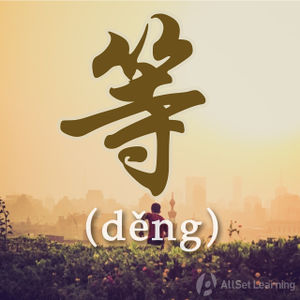Difference between revisions of "Non-exhaustive lists with "dengdeng""
| Line 15: | Line 15: | ||
<div class="liju"> | <div class="liju"> | ||
| − | *西瓜、菠萝、葡萄 <em>等等</em> ,我 都 喜欢 吃 。 <span class="pinyin">Xīguā, bōluó, pútao, <em>děngděng</em>, wǒ dōu xǐhuan chī.</span><span class="trans">Watermelons, pineapples | + | *西瓜、菠萝、葡萄 <em>等等</em> ,我 都 喜欢 吃 。 <span class="pinyin">Xīguā, bōluó, pútao, <em>děngděng</em>, wǒ dōu xǐhuan chī.</span><span class="trans">Watermelons, pineapples, grapes, and so on... I like them all.</span> |
*我 爸爸 很 喜欢 运动 ,比如 跑步、游泳、打羽毛球 <em>等等</em> 。<span class="pinyin">Wǒ bàba hěn xǐhuan yùndòng, bǐrú pǎobù, yóuyǒng, dǎ yǔmáoqiú, <em>děngděng</em>.</span><span class="trans">My father likes different sports, for example, running, swimming, playing badminton, etc.</span> | *我 爸爸 很 喜欢 运动 ,比如 跑步、游泳、打羽毛球 <em>等等</em> 。<span class="pinyin">Wǒ bàba hěn xǐhuan yùndòng, bǐrú pǎobù, yóuyǒng, dǎ yǔmáoqiú, <em>děngděng</em>.</span><span class="trans">My father likes different sports, for example, running, swimming, playing badminton, etc.</span> | ||
*<span class="spaced">Bruce Li、Jackie Chan、Jet Li </span> <em>等</em> 都 是 功夫 明星 。 <span class="pinyin">Bruce Li, Jackie Chan, Jet Li <em>děng</em> dōu shì gōngfu míngxīng.</span><span class="trans">Bruce Li, Jackie Chan, Jet Li, etc. are all kung fu stars.</span> | *<span class="spaced">Bruce Li、Jackie Chan、Jet Li </span> <em>等</em> 都 是 功夫 明星 。 <span class="pinyin">Bruce Li, Jackie Chan, Jet Li <em>děng</em> dōu shì gōngfu míngxīng.</span><span class="trans">Bruce Li, Jackie Chan, Jet Li, etc. are all kung fu stars.</span> | ||
Revision as of 02:16, 8 January 2019
-
Level
-
Similar to
-
Used for
-
Keywords
等等 (děng děng) or simply 等 (děng), is just like saying “and so on” or “etc.” in English, but it's just a bit more formal. Both are placed after listing a series of items (generally with a list that exceeds two items).
Structure
The basic structure is easy. Just make a list of things and add 等 (děng) or 等等 (děng děng) to the end of the list. It's the same as in English when we use "etc." at the end of a list, except in Chinese you don't put a final comma before the 等 or 等等.
A1,A2 ⋯⋯ 等 / 等等
Examples
- 西瓜、菠萝、葡萄 等等 ,我 都 喜欢 吃 。 Watermelons, pineapples, grapes, and so on... I like them all.
- 我 爸爸 很 喜欢 运动 ,比如 跑步、游泳、打羽毛球 等等 。My father likes different sports, for example, running, swimming, playing badminton, etc.
- Bruce Li、Jackie Chan、Jet Li 等 都 是 功夫 明星 。 Bruce Li, Jackie Chan, Jet Li, etc. are all kung fu stars.
- 我们 公司 有 市场部、设计部、技术部 等等 。Our company has a marketing department, design department, technology department, etc.
- 联合国 的 工作 语言 有 英语、法语、西班牙语 等 。The working languages of the UN are English, French, Spanish, etc.
等 (děng) can also be added to the end of a list and is followed by a noun that represents the list. In this case, you can only use 等:
A1,A2 ⋯⋯ 等 + [Category] + Predicate
The predicate part of the pattern can be a verb or an adjective.
- 长城、故宫 等 景点 都 是 北京 有名 的 景点 。 The Great Wall, the Forbidden City, etc. are all famous tourist attractions in Beijing.
- 北京、上海、广州 等 城市 的 经济 都 很 发达 。Beijing, Shanghai, Guangzhou and so on are economically developed cities.
- 牛津、剑桥 等 大学 是 英国 最 有名 的大学 。Oxford, Cambridge and so on are the most famous British universities.
- 中国、印度、巴西 等 国家 都 是 发展中 国家 。China, India, Brazil and so on are all developing countries.
- 食品 安全、空气 污染、人工 智能 等 话题 都是 热点 话题 。Food safety, air pollution, artificial intelligence, and so on are all hot topics.



